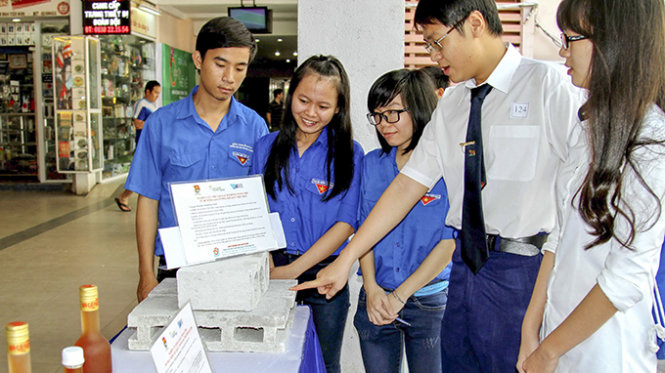A student from Ho Chi Minh City has recently successfully created unburned bricks from waste paper.
The project of fifth year student Nguyen Cao Hoang Sang from the Construction Department of the HCMC University of Architecture has been highly appreciated by local scientists for its applicability.
It took Sang seven months to finish his work, which won the first prize of the 2014 student scientific contest Eureka held by the Ho Chi Minh City chapter of the Ho Chi Minh Communist Youth Union in collaboration with the Vietnam National University-Ho Chi Minh City.
Sang said he has cherished and searched for many ways to produce an environmentally-friendly material for a long time.
To conduct his project, Sang collected waste paper from many places, including classes, photocopy shops, and bookstores, and then milled them with sand to create aggregate. Cement and water later will be added as adhesives for the bricks.
Sang also created a specific paper blender to mill paper.
After that, he continued to mold bricks to identify the load bearing capacity of each type of brick.
“This step is very important since it decides if the brick is able to be used,” Sang said.
Sang has created two kinds of brick, including one that has an allowable-load bearing capacity of 35kg, to replace the traditional burned clay brick which is used to construct house’s inside walls.
The other kind of brick Sang has created is one with an allowable-load bearing capacity of 75kg, to replace the traditional two-hole bricks which are used to build outside walls, especially for building construction.
The next step is dipping the bricks in water for a week so that they can gain the necessary hardness before being fired in an oil oven in 30 minutes.
With its simple production process, this kind of brick is expected to be produced at small brick manufacturing facilities. If Sang’s project is put into operation, the price of each brick made from waste paper would be around VND6,000.
“The most outstanding advantage of the bricks made from waste paper is that they are light-weight,” Sang said. “So it will be easy for workers to work with the material.”
“Also, its soundproof and insulation abilities, which are higher than cement bricks, will make waste paper bricks a competitive product in the market,” he added.
Moreover, producing the bricks can also take advantage of waste sawdust at paper manufacturing factories, sharply decreasing the risk of environmental pollution.
Sang is also planning to research and create an additive in order to glue the unburned bricks, improving the efficiency when his kind of brick is used in the real world.






















































